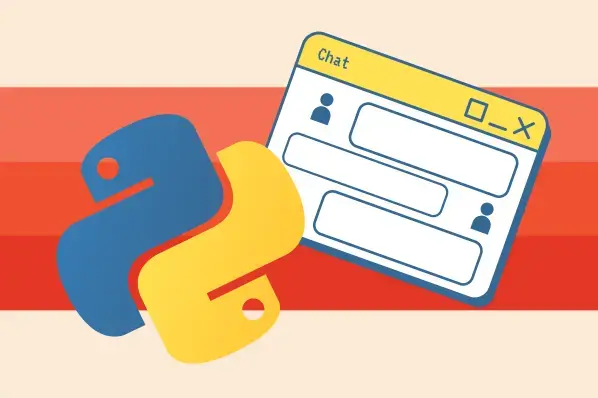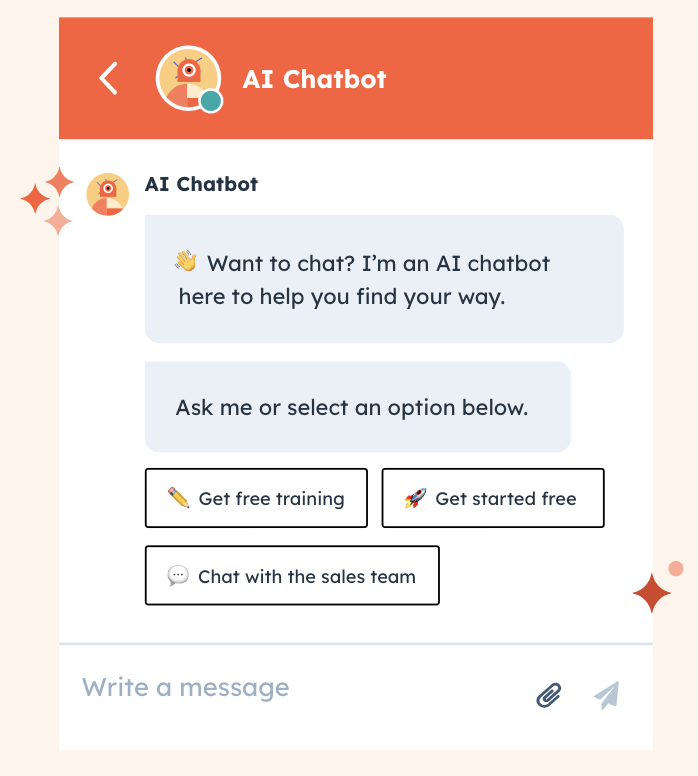In this post, I’ll guide you through the world of NLP and LLM, help you understand different types of chatbots, and then it’s time for you to step into the shoes of an AI developer and start building your first Python AI chatbot from scratch.
Table of Contents
- Python, AI, and Chatbots (Brief Overview)
- What are Python AI chatbots?
- Types of Chatbots
- Exploring LLM-Powered Natural Language Processing (NLP) in Python
- Building Your First Python AI Chatbot with OpenAI
- Challenges and Solutions in Building LLM Python AI Chatbots
- Final Thoughts and Next Steps
Python, AI, and Chatbots (Brief Overview)
Most AI developers I know use Python as the main programming language for building AI applications. Python is easy to learn and has extensive libraries to work with. Basically, Python is more versatile, accessible, and efficient compared to languages like Java and C++. For example, with Python, I can create a software function with fewer lines than in Java.
Although Python is enjoying the limelight today, the language has been around since the 1990s. I remember coding with Python 15 years ago, long before chatbot was even a thing. Over the years, Python has gone through several changes, but much of its syntax, or coding rules, remains the same.
At its core, Python remains the simple programming language I knew. And today, it’s favored for data science, machine learning, and LLMs. Likewise, chatbots have advanced leaps and bounds over the years. They went from simple, limited Q&A bots to natural conversationalists powered by LLMs like Generative Pre-trained Transformer (GPT).
But can you create an AI chatbot with Python without extensive programming experience? Well, with today’s technologies, you can. And that’s what I hope to show in the sections below.
What are Python AI chatbots?
Python AI chatbots are software applications designed to simulate human-like conversation using natural language processing (NLP). These intelligent bots can understand and respond to text or voice inputs in natural language.
Modern AI chatbots are often powered by LLMs, which are trained from volumes of conversational and linguistic data. This gives the chatbot exceptional NLP capability that exceeds the limits of previous machine learning or rule-based chatbots. Instead of relying on scripts, modern AI chatbots can converse and reason in real time just like humans do.
For example, ChatGPT, the generative AI interface many of us are familiar with, is powered by GPT. It also becomes the foundation of many business chatbot applications, including providing seamless customer service, answering queries, or even making product recommendations.
So, how does Python fit in?
Python plays a crucial role in creating and repurposing AI chatbots for various use cases. I like to think of Python as the glue that brings every AI and software feature together. With Python, you can:
- Use available AI libraries (e.g., OpenAI, transformers, spaCy).
- Build conversational logics.
- Connect with business functions.
- Integrate the chatbot algorithm with web apps.
Benefits of Using Chatbots
Here are some of the advantages of using chatbots I’ve discovered and how they’re changing business dynamics.
Prompt Customer Service
Chatbots can pick up the slack when your human customer reps are flooded with customer queries. These bots can handle multiple queries simultaneously and work around the clock. Instead of putting customers on hold or tackling queues of support tickets, chatbots help accelerate problem resolutions.
Simplify Your Staffing Needs
Some AI chatbots have strong reasoning capabilities. When connected to your company’s knowledge base, chatbots can resolve simple queries and redirect complex ones to human personnel. Let’s say a customer needs help to set up a product. They can ask their question, and the chatbot will direct them to a step-by-step video guide.
For startups and small businesses, this allows you to scale your customer service operations without growing beyond your budget. You can keep your team lean until you secure enough capital to grow.
Increased Revenue
Chatbots can create a hyper-personalized interaction the moment prospects start asking questions. Based on the responses, chatbots can ask qualifying questions, so that you can funnel high-quality leads that are more likely to convert. In addition, you can also use a chatbot to segment customers and direct them to targeted campaigns.
Improved Employee Experience
Chatbots can make your team happier. They can use chatbots to automate routine tasks, which often take up precious time. More importantly, chatbots can be an adept virtual helper, whether for sales, marketing, research, product development, or other business areas.
For example, I use chatbots to resolve coding issues, a task that used to stress me out. And when I face writer’s block, I bounce ideas with a chatbot to unleash my creative flow again.
Types of Chatbots
Before I dive into the technicalities of building your very own Python AI chatbot, let’s explore the different types of chatbots that exist.
Understanding the types of chatbots and their applications helps you determine the best fit for your needs. The choice ultimately depends on your chatbot’s purpose, the complexity of tasks it needs to perform, and the resources available to you.
Rule-Based Chatbots
These chatbots operate based on predetermined rules that they are initially programmed with. They are best for scenarios that require simple query–response conversations. Their downside is that they can't handle complex queries because of limited intelligence. On top of that, rule-based chatbots can’t learn from ongoing interactions.
For example, let’s assume you run an ecommerce website. You can use a rule-based chatbot to do things like:
- Answer frequently asked questions.
- Run a quiz that tells customers about their shopping habits.
- Schedule appointments through a series of questions.
Machine Learning Powered Chatbots
Machine learning (ML) powered chatbots are trained on large datasets, which then lets them interact conversationally with customers.
Unlike rule-based chatbots, ML-powered chatbots are better at conversations. These chatbots are well-suited for complex tasks, but their implementation can be more challenging. Often, you’ll need to fine-tune them before you can use the chatbot for specific business cases.
For example, a machine learning chatbot can show the tracking number when a customer asks, “Can I track my shipment?"
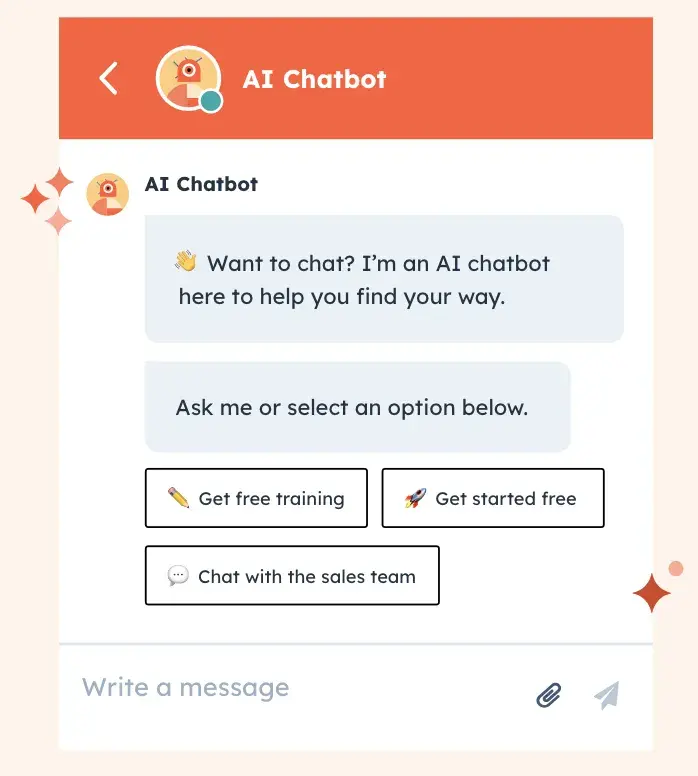
Hybrid Chatbots
As the name suggests, these chatbots combine the best of both worlds. They operate on pre-defined rules for simple queries and use machine learning capabilities for complex queries. Hybrid chatbots offer flexibility and can adapt to various situations, making them a popular choice.
For example, you can use hybrid chatbots to reduce abandoned carts on your website. When users take too long to complete a purchase, the chatbot can pop up with an incentive. And if users abandon their carts, the chatbot can remind them whenever they revisit your store.
Generative Chatbots
Generative chatbots are powered by LLMs. They train on books, web content, and other textual datasets. The result? State-of-the-art chatbots with human-like reasoning capabilities. Moreover, they can learn from the conversation’s context in real time.
In simple words, generative chatbots can produce more relevant, coherent, and consistent responses than other types of chatbots. ChatGPT, Claude, and Gemini are common examples of generative AI chatbots.
Many companies have turned to generative chatbots to improve operational efficiency, increase customer experience, and reduce costs. For example, I learned that Air India powers its virtual agent with ChatGPT. Whether booking a ticket or checking flight status, customers can “talk” to the chatbot just like they would to a support personnel.
Next, let’s see how Python plays a crucial role in the creation of these chatbots.
Exploring LLM-Powered Natural Language Processing (NLP) in Python
NLP is the cornerstone of any intelligent chatbot.
NLP is a subfield of AI that focuses on the interaction between humans and computers using natural language. The ultimate objective of NLP is to read, decipher, understand, and make sense of human language in a valuable way.
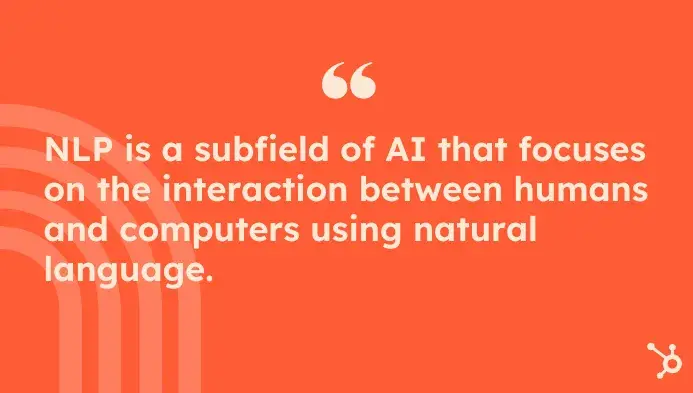
Before LLMs became publicly available, software developers used traditional machine learning techniques to power NLP capabilities. They use Python libraries like Natural Language Toolkit (NLTK), SpaCy, and TextBlob when building a chatbot. These libraries contain packages to perform tasks from basic text processing to more complex language understanding tasks.
For instance, R vs Python and its NLTK library helps with everything from splitting sentences and words to recognizing parts of speech (POS). On the other hand, SpaCy excels in tasks that require deep learning, like understanding sentence context and parsing.
Still, this approach comes with various challenges and mostly involves manual work. For example, I had to extensively fine-tune an ML-powered chatbot I built before I could repurpose it for work.
However, with LLMs coming into play, building an AI chatbot becomes simpler. Most LLMs, such as GPT-4, Gemini, and Claude, are pre-trained. Also, they’re more adaptable and responsive to various contexts. This means the chatbot you build can converse intelligently right from the start.
On top of that, you can find various tools, frameworks, and resources to integrate LLM with your AI chatbot. For example:
- OpenAI’s Python library lets you access their latest models like GPT-4.
- LangChain provides comprehensive resources to build and integrate your LLM-powered chatbot with other components.
- HuggingFace transformer provides various pre-trained LLM models that you can build on.
Simply put, as LLMs continue to mature, building a basic Python AI chatbot now takes minutes instead of hours.
Implementing RAG for Knowledge-Based Chatbots
Building an AI chatbot is one thing. But building one that can answer queries specific to your business is another.
Here’s why.
LLMs are trained on generic information, which they base their responses on. Often, when asked a question that they haven’t learned before, LLMs cannot respond accurately.
For example, if you ask ChatGPT, “What is the refund policy of a [company]”, it might not be able to return an accurate answer because it doesn’t have the information firsthand. So, AI developers would either need to fine-tune the LLM or connect it to a knowledge base. The latter approach is called retrieval-augmented generation (RAG).
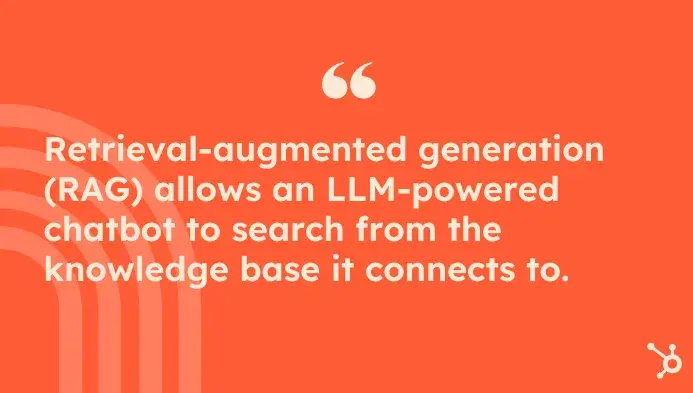
RAG allows an LLM-powered chatbot to search from the knowledge base it connects to. This is more cost-friendly and faster than training or fine-tuning the chatbot with business-specific information.
With RAG, the chatbot finds and retrieves business-specific information from documents, databases, or other storage. Then, it generates a response with its pre-trained knowledge for the user.
Building Your First Python AI Chatbot with OpenAI
Now that we have a solid understanding of NLP and the different types of chatbots, it‘s time to get our hands dirty.
In this section, I’ll walk you through a simple step-by-step guide to creating your first Python AI chatbot. I’ll use Google Colab, LangChain, and OpenAI to put together a chatbot with RAG capabilities.
Step 1: Sign up for Google Colab.
Google Colab is a cloud-based Python development environment. Instead of writing and running the code on your computer, it allows you to leverage cloud CPUs, GPUs, and TPUs. The best thing is, you can use Colab for free.
On my Google Colab dashboard, I created a new notebook. Then, I named the notebook with something relatable, like “Python AI RAG”.
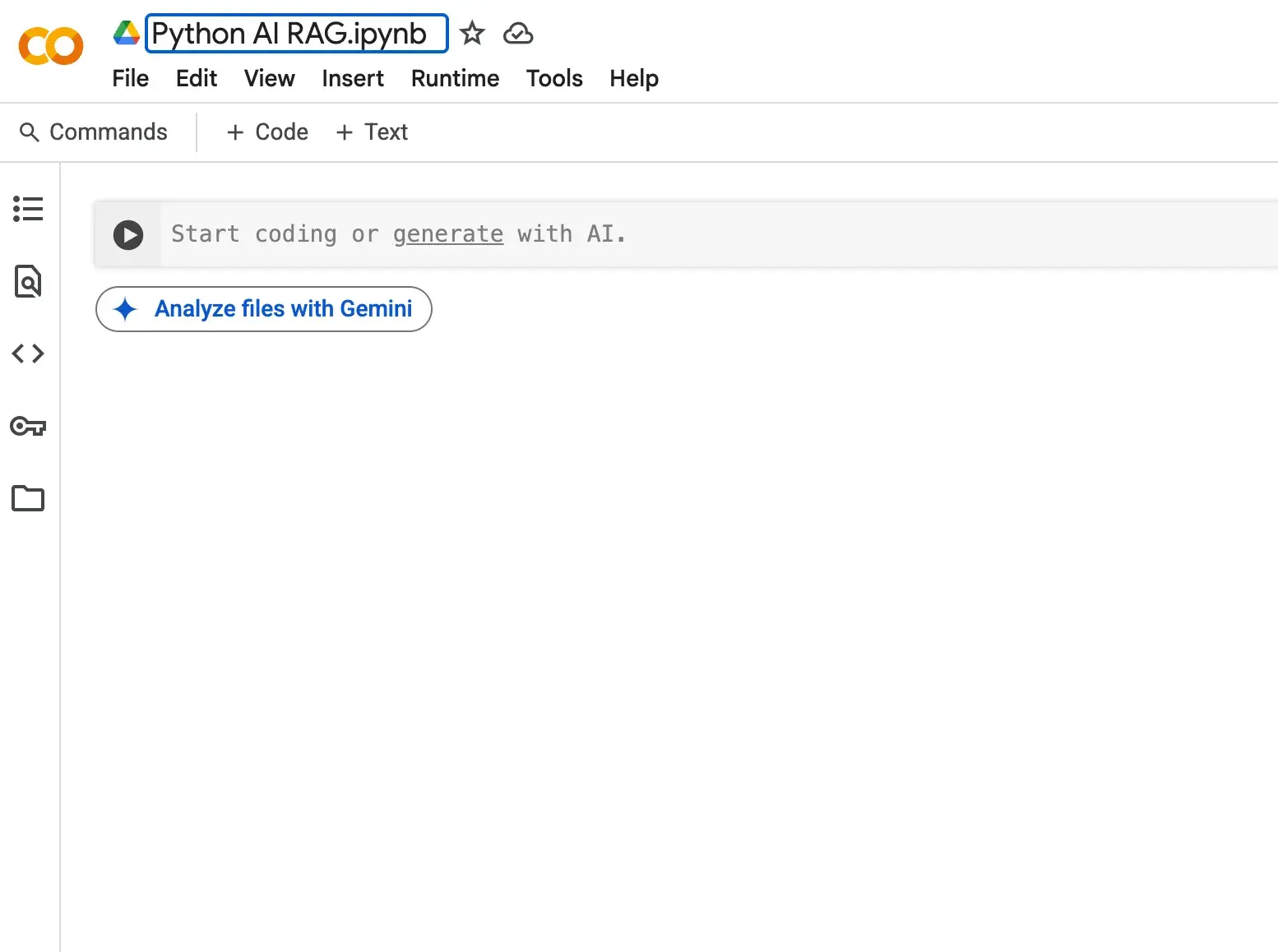
Step 2: Create an OpenAI API key.
Next, I created an API Key on OpenAI, which I’ll later use for accessing LLM functions. One thing to remember, though, is to copy your API Key immediately after creating it. Don’t lose the API key and never share it with anyone.

Step 3: Install and import required libraries.
Next, I created a new code cell, which lets you write Python code. Then, include libraries that you’ll use in creating the chatbot.
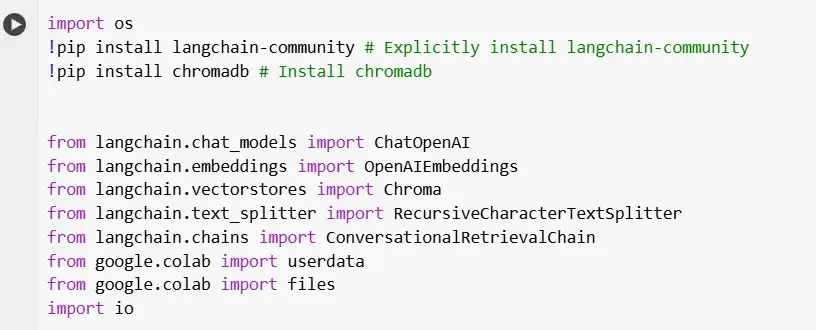
Step 4: Set up your OpenAI API key.
Google Colab lets you store your OpenAI API key safely. On the sidebar, click the key icon and paste the OpenAI API key in the value textbox.
Then, give it a name and turn on Notebook access to use the key in your code.
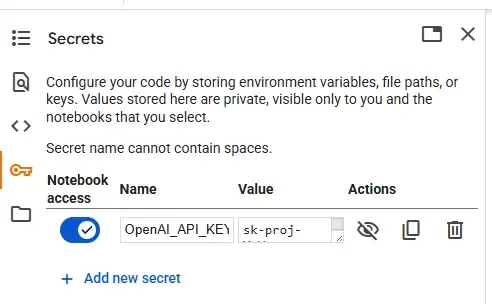
Next, I add the following code to the editor. This will safely load the OpenAI API Key to your code when it runs.

Step 5: Implement RAG.
Instead of directly conversing with the LLM, I connect it to a proprietary knowledge base. In this example, I created a file called “knowledge_base.txt”. The text file contains business-specific information that the AI model is unaware of.
Note that I have made up the company and business information in my example below. You can, however, use actual information from your business knowledge base. Also, to simplify the code, I use a text file. In actual applications, you can load the knowledge base in other formats, such as PDF.
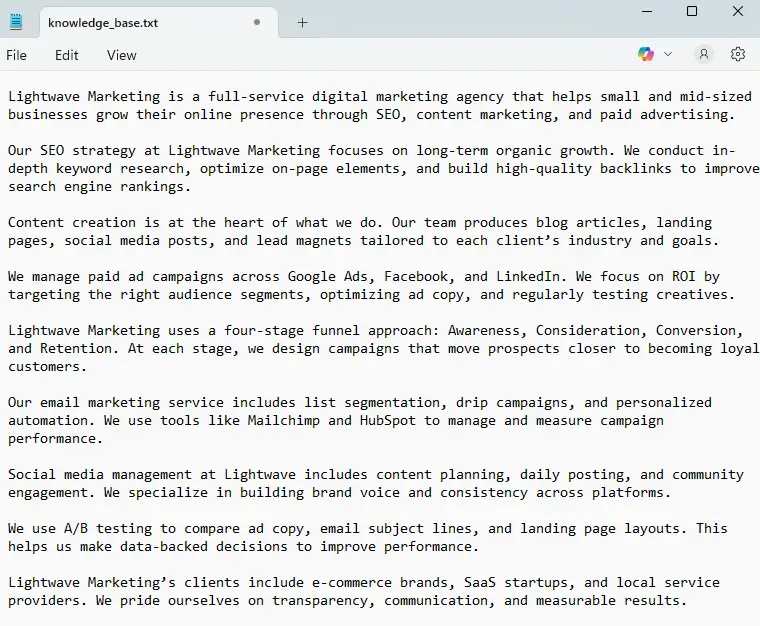
Next, include the following code to create a knowledge base that the chatbot will refer to. When the code runs, it’ll prompt you to upload the knowledge base file. The code splits the text into smaller parts and tags them with numerical representations called embeddings. Finally, these embeddings are stored in a special database called vectorstore.
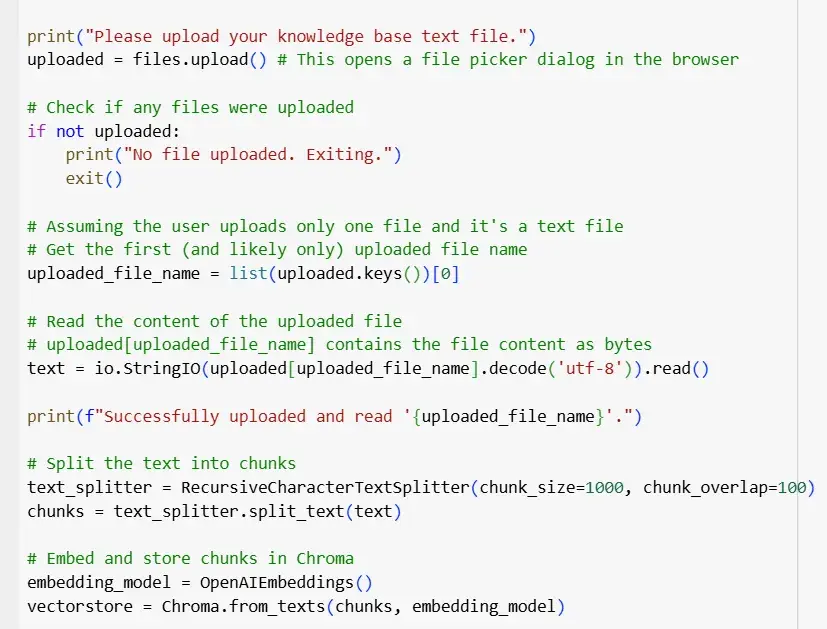
Step 6: Create the RAG chatbot.
Next, it’s time to initialize your chatbot. Below, I use GPT-4o as the LLM, but you can replace it with other models.

Step 7: Run the RAG chatbot.
Next, create a chatbot that uses the vectorstore and past conversations when responding to questions. Note how I let the chatbot run indefinitely until the user types “exit.”
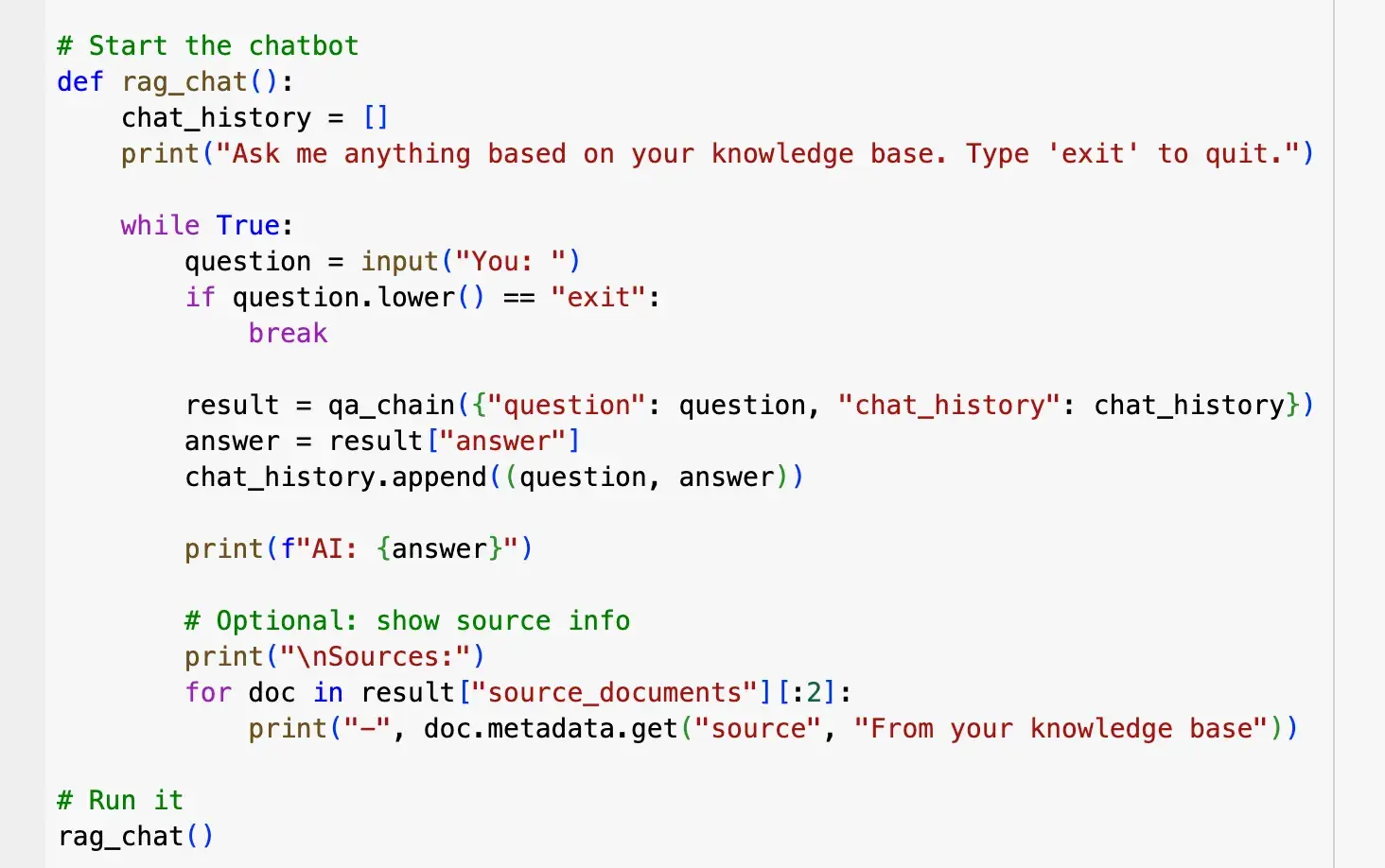
Here’s what the conversation looks like when I ask the chatbot about the services that Lightwave Marketing offers.
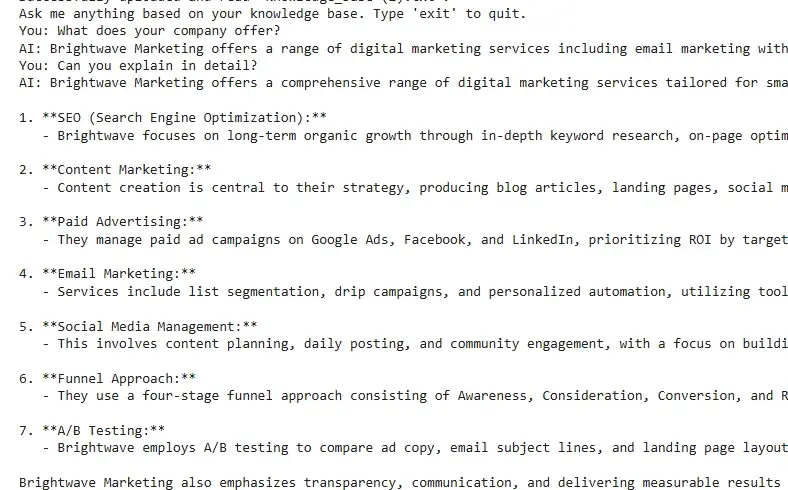
By following these steps, you'll have a functional Python AI chatbot to integrate into a web application. This lays the foundation for more complex and customized chatbots, where your imagination is the limit.
I recommend experimenting with different training sets, algorithms, and integrations to create a chatbot that fits your unique needs and demands.
If you want to try the AI chatbot code I created, here’s the link to my Google Colab project.
Challenges and Solutions in Building LLM Python AI Chatbots
Although modern development tools have simplified chatbot development, there are challenges you need to be aware of. Here are a few that I think are the most pertinent right now.
Challenge 1: Hallucination
Problem: LLMs, despite having greatly improved, can still hallucinate and provide inaccurate information that seems plausible. Hallucination happens because of several reasons, including biased training datasets and limitations in the language model you use.
Solution: Use RAG to expand the LLM’s knowledge base, which reduces the risk of hallucination. In addition, you can fine-tune the model to manage uncertainty and add human-in-the-loop guardrails to prevent factually incorrect information from reaching the end users.
Challenge 2: Infrastructure Cost
Problem: Training and operating an LLM Python chatbot requires significant computing power, which some businesses might struggle to provide on-premise. Plus, if you use the API to integrate with pre-trained LLMs, the fee you pay can become expensive as usage increases.
Solution: Not all chatbots require a powerful and expensive LLM. You can offload simple tasks to rule-based or machine learning models to limit operational expenses. Also, take advantage of cloud providers, which allow you to scale and pay only for the computing resources you use.
Challenge 3: Data Security and Privacy
Problem: Whether you’re training an LLM from scratch or using the RAG approach, you need to protect the data collected, stored, and used. Otherwise, you risk exposing data, intentionally or unintentionally, which can jeopardize customer trust and lead to legal issues.
Solution: Implement security measures, such as end-to-end encryption and access management, to prevent unauthorized access to chatbot data. Also, remember to anonymize any sensitive information used to comply with data privacy regulations.
Challenge 4: Integration Complexities
Problem: I’ve shown you how to build a simple chatbot. But the challenge lies in integrating it with your database, CRM, web app, and other interfaces, which can be time-consuming.
Solution: When possible, use APIs, programming frameworks, and middleware to accelerate integration efforts.
Challenge 5: Scaling and Deployment
Problem: As your chatbot gets more complex, it may face issues related to performance, scalability, and deployment.
Solution: Plan for scalability from the get-go. Use scalable cloud services and robust deployment practices. Monitor performance regularly and optimize as needed.
Remember, overcoming these challenges is part of the journey of developing a successful AI chatbot. Each challenge presents an opportunity to learn and improve, ultimately leading to a more sophisticated and engaging chatbot.
Final Thoughts and Next Steps
I think building a Python AI chatbot is an exciting journey filled with learning and opportunities for innovation. By now, you should have a good grasp of what goes into creating a basic chatbot, from understanding NLP to identifying the types of chatbots and, finally, constructing and deploying your own RAG-based LLM chatbot.
But the journey doesn't stop here. Chatbots are constantly evolving, with new techniques and tools being introduced regularly. To build a truly engaging and intelligent chatbot, I recommend following these next steps.
- Explore advanced NLP techniques. Dive deeper into LLM-powered NLP and familiarize yourself with more advanced concepts like sentiment analysis, text summarization, and context-aware question answering.
- Integrate with external tools. Expand your chatbot functionality by connecting with enterprise services and APIs. This allows the chatbot to retrieve data, reason, and help with decision-making in real time.
- Experiment with different LLM frameworks. Beyond LangChain, there are other libraries like LlamaIndex and Haystack that offer RAG functionalities and are worth exploring.
- Customize your chatbot. Tailor your chatbot to specific use cases. Whether it's a customer service chatbot for an ecommerce website or a personal assistant chatbot, the potential is limitless.
- Learn about deployment and scaling. Learn about deploying your chatbot to different platforms and how to scale it to handle increased traffic and complexity.
In my experience, building chatbots is as much an art as it is a science. So, don't be afraid to experiment, iterate, and learn along the way.
Editor's note: This post was originally published in April 2024 and has been updated for comprehensiveness.
Chatbots

